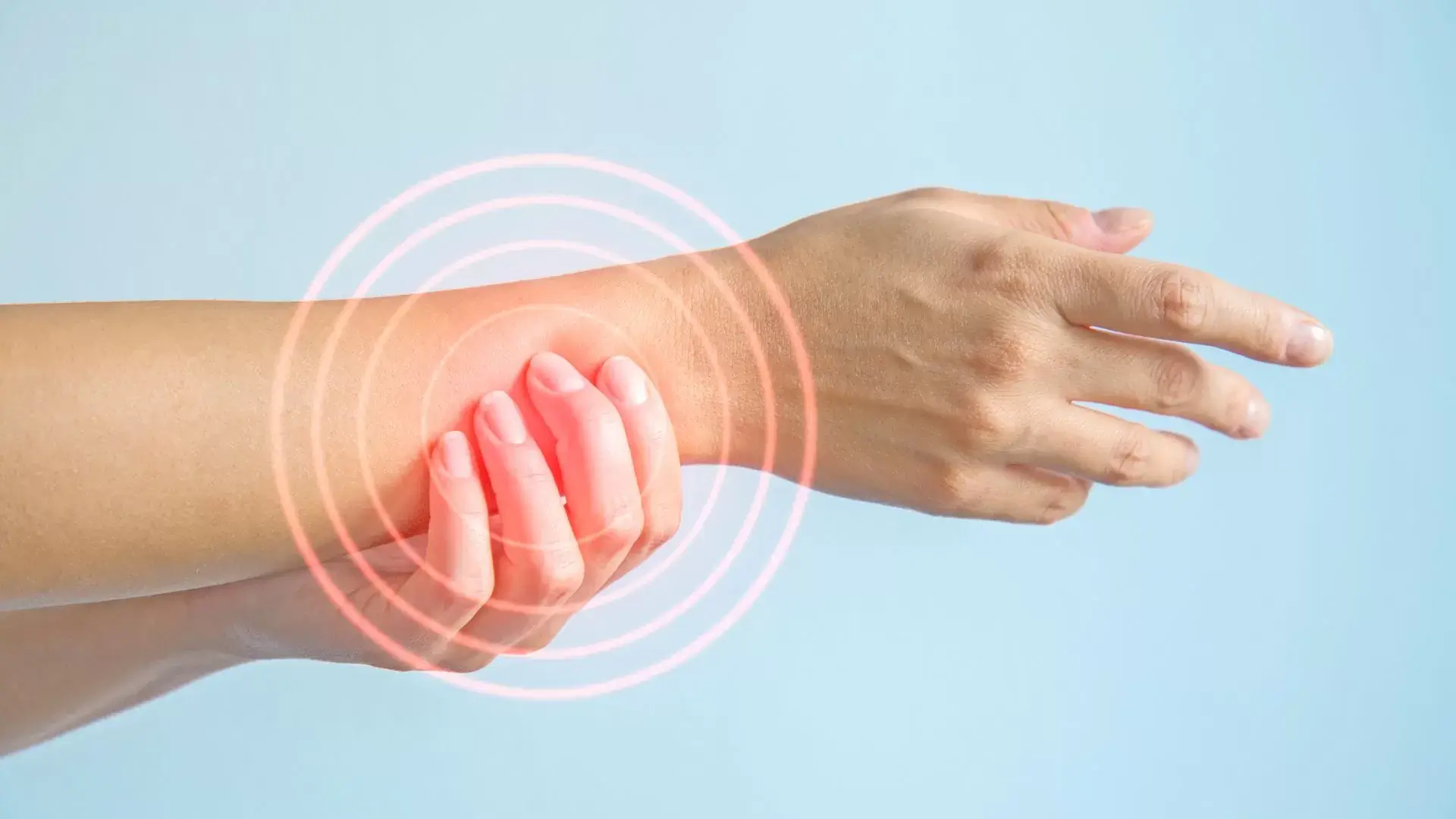We recognize how Carpal Tunnel Syndrome (CTS) can disrupt daily life, causing pain and numbness in your hands. In Mississauga, our Chiropractor for Carpal Tunnel Syndrome focuses on alleviating these symptoms through targeted wrist adjustments, nerve gliding exercises, and muscle relaxation techniques. We prioritize non-invasive methods to enhance mobility and reduce inflammation, helping you regain function. Our personalized treatment plans also include guidance on ergonomic adjustments and lifestyle modifications to prevent future issues. If you’re seeking relief and a return to normalcy, we’re here to assist you, and there’s more to explore about our thorough approach to CTS care.

At Mississauga Physio Chiro Clinic, we specialize in tailored physiotherapy and chiropractic services designed to alleviate pain and improve function for those suffering from conditions like carpal tunnel syndrome. We recognize that median nerve compression can lead to significant wrist pain and discomfort. Our all-encompassing approach begins with a thorough assessment to identify the specific nature of the nerve entrapment affecting each individual.
Through our Best Physiotherapy and Chiropractic Care in Mississauga, we focus on a combination of hands-on techniques and targeted wrist exercises aimed at reducing symptoms and restoring mobility. We also emphasize the importance of ergonomic adjustments in the workplace to minimize strain on the wrists, which can help prevent further issues.
Additionally, our occupational therapy services are available to support individuals in modifying their activities to guarantee a sustainable recovery. By empowering our clients with knowledge and strategies, we aim to foster a proactive approach to managing their condition.
Together, we’ll work towards enhancing your quality of life, alleviating discomfort, and enabling you to return to the activities you enjoy. Your journey to recovery starts here, and we’re committed to supporting you every step of the way.
Carpal Tunnel Syndrome (CTS) is primarily caused by compression of the median nerve, leading to a range of symptoms that can greatly impact daily activities and overall quality of life. We often see patients experiencing hand numbness and tingling in fingers, which can be particularly bothersome at night, resulting in nocturnal symptoms that disrupt sleep.
Wrist inflammation is another common issue associated with CTS, frequently stemming from repetitive strain injury due to poor workplace ergonomics. When we engage in activities that involve prolonged wrist flexion or repetitive motions, such as typing or using handheld devices, the risk of nerve compression increases.
Addressing CTS effectively requires a thorough approach, including inflammation control and lifestyle changes. We recommend incorporating physical therapy to strengthen the wrist and improve flexibility. Additionally, adjusting workplace ergonomics can help prevent further strain on the median nerve. By being proactive and making these adjustments, we can greatly reduce symptoms and enhance our overall quality of life. Understanding these causes and effects is the first step toward finding effective relief and regaining control over our daily routines.
Finding effective relief from the symptoms of Carpal Tunnel Syndrome often leads us to explore various therapeutic options, and chiropractic care offers a promising approach to alleviate discomfort and restore function. Through targeted chiropractic solutions, we can enhance wrist mobility and improve overall hand function.
Our treatment may include specialized wrist mobility exercises and nerve gliding exercises designed to relieve pressure on the median nerve. These methods not only aid in pain management but also promote flexibility and strength in the affected area. Trigger point therapy can further help by addressing muscle tightness that may contribute to symptoms.
Incorporating muscle strengthening exercises into our routine is essential for preventing future issues, especially for those engaged in computer-related RSI. Additionally, a chiropractor can provide insights on workplace injury prevention, ensuring our workstations are ergonomically sound.
While some may consider surgical decompression as a last resort, chiropractic care often serves as an effective initial intervention. By exploring these holistic approaches, we can find the carpal tunnel syndrome relief we need, empowering us to return to our daily activities with greater ease and comfort.
Recognizing the symptoms of Carpal Tunnel Syndrome is essential for us to seek timely intervention and prevent further complications. One of the most common indicators is chronic wrist pain, which can manifest as wrist stiffness or swelling. We may also experience hand weakness and grip strength loss, making it difficult to perform everyday tasks.
Additionally, numbness in the index and middle fingers, along with thumb weakness, often signals that something isn’t right. If we notice that our symptoms worsen after repetitive hand movements—like typing or using a mouse—it’s vital to take note. These activities can exacerbate our discomfort and lead to more severe issues if left unaddressed.
In some cases, our healthcare provider may recommend nerve conduction studies to confirm the diagnosis and assess the severity of our condition. By recognizing these symptoms early, we can take proactive steps toward relief and recovery. Understanding what we’re experiencing helps us communicate more effectively with our chiropractor or healthcare professional, paving the way for tailored treatment options that address our specific needs. Let’s prioritize our hand health and take action when we notice these signs.

Often, we underestimate the critical role that median nerve compression plays in our hand function and overall quality of life. When this nerve becomes compressed, typically due to wrist overuse or structural issues involving the carpal tunnel anatomy, we can experience significant hand dysfunction. This includes dexterity issues that affect our ability to perform daily tasks, leading to frustration and discomfort.
The transverse carpal ligament, which forms the roof of the carpal tunnel, can become a source of pressure on the median nerve. As we explore treatment options, anti-inflammatory treatment and tendon gliding exercises can be beneficial in alleviating symptoms. These approaches help reduce inflammation and improve flexibility, promoting better nerve function.
For those considering post-surgical rehabilitation, it is crucial to understand the importance of both recovery and preventative care. Chiropractic therapy can play an important role in this process, offering methods to enhance wrist mobility and strength, thereby minimizing the risk of future complications. By addressing median nerve compression holistically, we can restore hand function and improve our overall quality of life, making our daily activities more manageable and enjoyable.
Chiropractic methods can effectively relieve wrist pain and alleviate nerve pressure, offering a holistic approach to managing symptoms associated with carpal tunnel syndrome. We recognize how frustrating this condition can be, and our goal is to provide thorough care.
One effective strategy involves the use of wrist splints, which can stabilize the wrist and reduce strain on the median nerve. Alongside this, we often recommend hand therapy to improve strength and flexibility. Electromyography may also be utilized to assess nerve function, guiding our treatment plan.
Incorporating stretching exercises into our routine can enhance mobility and relieve tension in the wrist and forearm. Additionally, massage therapy plays an essential role in relaxing tight muscles and improving circulation, further aiding in relieving wrist pain.
We also advocate yoga for wrist pain, as certain poses can help stretch and strengthen the relevant areas, promoting overall wrist health. By combining these chiropractic methods, we aim to create a personalized treatment plan that addresses both immediate discomfort and long-term recovery, ensuring you can regain function and comfort in your daily activities. Together, we can work towards alleviating your symptoms and enhancing your quality of life.
Maintaining proper workplace ergonomics is essential for preventing carpal tunnel syndrome and reducing the risk of repetitive strain injuries (RSI) that can arise from prolonged computer use and awkward hand positioning. We often overlook how our workspace affects our health, yet small adjustments can make a notable difference.
To promote better ergonomics, we should make certain our chairs and desks are at appropriate heights, allowing our forearms to remain parallel to the floor while typing. This position helps prevent forearm pain and reduces the likelihood of developing a typing injury. Using wrist braces during breaks or when symptoms arise can offer additional support and relief.
If we do experience discomfort, options like splint therapy, corticosteroid injections, ultrasound therapy, or electrotherapy can help manage symptoms effectively. By prioritizing ergonomics in our daily routines, we can greatly lower our risk of carpal tunnel syndrome and other related conditions. Regular breaks and stretching are also essential to maintain flexibility and circulation. Together, let’s commit to creating healthier work environments that not only enhance productivity but also safeguard our well-being.
While improving workplace ergonomics can greatly reduce the risk of carpal tunnel syndrome, we should also explore natural approaches to alleviate wrist inflammation and pain when symptoms arise. One effective method is acupuncture, which can help reduce discomfort and promote healing by targeting specific points in the wrist and surrounding areas.
Cold therapy is another beneficial approach, especially in the initial stages of discomfort. Applying ice packs can help reduce inflammation and numb pain. Conversely, heat therapy can be useful for chronic issues, as it increases blood flow and promotes relaxation in tense muscles.
We must also consider nutritional factors, such as vitamin B6 deficiency, which has been linked to increased susceptibility to carpal tunnel syndrome. By ensuring a balanced diet, we can support our overall health.
For those experiencing diabetes-related CTS, managing blood sugar levels is vital to reducing symptoms. Additionally, addressing scar tissue management through gentle massage or physical therapy can promote mobility and decrease pain.
In some cases, a nerve block may be necessary for immediate relief. By combining these natural approaches, we can effectively manage wrist inflammation and pain, enhancing our quality of life.

Incorporating stretching and strengthening exercises into our daily routine can greatly aid in managing carpal tunnel syndrome (CTS) symptoms by improving flexibility and reducing muscle tension in the wrist and forearm. Stretching exercises, such as wrist flexor and extensor stretches, can help maintain the elasticity of the flexor tendons and alleviate discomfort. We can also perform strengthening exercises targeted at the muscles surrounding the wrist to enhance overall support and stability.
For those of us experiencing neuropathy, focusing on exercises that promote circulation can be particularly beneficial. It is crucial to keep in mind that conditions like hypothyroidism and rheumatoid arthritis can complicate CTS management, so we should adapt our exercise routines accordingly.
When incorporating these exercises, we might notice improvements in our ability to perform daily tasks, with some individuals even experiencing pinky finger sparing, which can indicate less severe nerve compression. Regular EMG assessments can help us monitor our progress and adjust our routines as needed. By committing to these exercises, we take significant steps toward alleviating CTS symptoms and enhancing our overall wrist health.
Chiropractic adjustments can play an essential role in alleviating carpal tunnel syndrome and forearm discomfort by realigning the wrist and improving nerve function. When we comprehend our chiropractor, we can expect a thorough assessment to identify the root causes of our pain, including any issues related to pregnancy-related CTS. Through targeted chiropractic adjustments, we can reduce inflammation and promote better blood flow, which is vital for healing.
At our clinic, located at 1834 Lakeshore Rd W #6C, Mississauga, ON L5J 1J7, we recognize the challenges of living with CTS. If conservative treatments don’t provide relief, we may discuss other options like carpal tunnel release surgery, including endoscopic carpal tunnel release and open carpal tunnel surgery. However, our focus remains on non-invasive methods first.
In addition to chiropractic adjustments, exploring alternative and non-surgical treatments can provide effective relief for carpal tunnel syndrome, helping us manage symptoms and improve overall hand function. One of the most beneficial approaches is ergonomic modifications. By adjusting our workstations or using supportive devices, we can alleviate pressure on the median nerve.
Physical therapy is another valuable option. Targeted exercises and stretches can enhance flexibility and strengthen the muscles in our hands and wrists, reducing discomfort. We might also consider using wrist splints, especially at night, to keep our wrists in a neutral position, which can greatly decrease pressure on the nerve.
Additionally, we could explore acupuncture or massage therapy, both of which have been shown to help relieve symptoms for some individuals. These therapies promote blood flow and can reduce inflammation.
Lastly, incorporating lifestyle changes, such as maintaining a healthy weight and managing stress, can also contribute to our overall well-being and symptom relief. By combining these alternative and non-surgical treatments with chiropractic care, we can create a thorough plan to effectively address carpal tunnel syndrome and enhance our daily functioning.
Rehabilitation after carpal tunnel syndrome (CTS) surgery is vital for restoring hand function and managing scar tissue effectively. Once the surgery is complete, we need to focus on a structured rehabilitation program that addresses both mobility and strength in the affected hand. This typically begins with gentle range-of-motion exercises to prevent stiffness and promote healing.
As we progress, we can incorporate strengthening exercises tailored to our individual needs, helping to regain functional use of our hands. It’s also important to monitor any scar tissue that may develop post-surgery. Scar tissue can limit mobility and cause discomfort, so techniques like massage, ultrasound therapy, and specific stretches can be beneficial in managing it.
We should remain patient during this process, as recovery may take time. Regular follow-ups with our chiropractor or physical therapist will guarantee we stay on track and make necessary adjustments to our rehabilitation plan. By committing to these practices, we can enhance our recovery, improve hand function, and ultimately return to our daily activities with greater ease and confidence. Together, we can navigate this journey towards full recovery, guaranteeing our hands regain their strength and functionality.
Accurate diagnosis of carpal tunnel syndrome (CTS) relies heavily on the insightful use of nerve conduction studies and electromyography (EMG), which provide essential information about nerve function and potential compression. These diagnostic tools help us assess the severity of nerve impairment and identify whether it’s indeed due to CTS.
In a nerve conduction study, we measure how fast electrical signals travel through the median nerve, which runs through the carpal tunnel. If the signals are delayed, it indicates possible nerve compression. EMG, on the other hand, evaluates the electrical activity of muscles, allowing us to see how well the muscles respond to nerve stimulation. Together, these tests help us pinpoint the exact nature of the problem.
We understand that undergoing these tests can be a bit overwhelming. However, they’re vital for ensuring that we provide the right treatment plan tailored to each individual’s needs. By accurately diagnosing CTS through nerve conduction studies and EMG, we can better guide our patients towards effective relief and rehabilitation strategies. Our goal is to alleviate discomfort and restore function, helping our patients return to their daily activities with confidence.
Chiropractic care for carpal tunnel syndrome (CTS) often addresses underlying health conditions that may contribute to nerve compression and discomfort. We recognize that issues such as diabetes, thyroid disorders, and rheumatoid arthritis can exacerbate CTS symptoms. By acknowledging these connections, our approach to treatment becomes more thorough and effective.
When we assess a patient with CTS, we consider their overall health profile. It is crucial to evaluate how conditions like obesity or hormonal imbalances may affect nerve function and fluid retention in the wrist. By addressing these underlying factors, we can help reduce inflammation and improve circulation, leading to better outcomes for our patients.
Our chiropractic techniques, including spinal adjustments and soft tissue therapies, aim to relieve pressure on the median nerve while also promoting overall well-being. We often recommend lifestyle changes and ergonomic adjustments tailored to each individual’s needs, ensuring that our patients not only find relief but also appreciate the importance of managing their overall health.
Ultimately, our goal is to empower our patients by addressing both the symptoms of CTS and the health issues that may be contributing to their discomfort, fostering long-term healing and resilience.
To effectively prevent carpal tunnel syndrome, we must adopt a proactive approach that includes ergonomic adjustments, regular breaks, and targeted exercises. First, let’s assess our workspaces. By ensuring our desks, chairs, and keyboards are properly aligned, we can minimize strain on our wrists and hands. Utilizing ergonomic tools, like wrist supports and adjustable chairs, can make a significant difference.
Next, we should prioritize taking regular breaks. Short pauses every hour can help alleviate tension and improve circulation. During these breaks, stretching our hands, fingers, and wrists can enhance flexibility and reduce the risk of injury.
Incorporating targeted exercises into our daily routines is also beneficial. Strengthening the muscles in our hands and forearms can provide better support for our wrists. Simple exercises, like wrist flexor and extensor stretches, can be done quickly and easily.
Lastly, we need to be mindful of our overall health. Maintaining a healthy weight, managing chronic conditions, and staying active can all contribute to reducing our risk of developing carpal tunnel syndrome. By implementing these strategies, we can work together towards a more comfortable and healthier future.
Seeking professional chiropractic care in Mississauga can greatly alleviate the discomfort associated with carpal tunnel syndrome. Many of us experience the nagging pain, tingling, or numbness in our hands and wrists that can disrupt our daily activities. It’s vital to understand that chiropractic care offers a holistic approach to managing these symptoms.
When we visit a chiropractor, we can expect a thorough assessment of our condition, including our posture, wrist alignment, and overall biomechanics. This extensive evaluation allows the chiropractor to create a tailored treatment plan that may include spinal adjustments, wrist manipulation, and targeted exercises. These techniques are designed to relieve pressure on the median nerve, reduce inflammation, and improve blood flow to the affected area.
Moreover, chiropractors often provide valuable advice on ergonomics and lifestyle modifications that can help prevent further issues. By addressing the root causes of our discomfort, we’re not only seeking relief but also promoting long-term health.
If we’re struggling with carpal tunnel syndrome, it’s important to seek expert chiropractic care in Mississauga. With the right support, we can reclaim our comfort and restore our everyday functionality. Contact us today!
Nestled in the Greater Toronto Area, Mississauga is a vibrant city known for its diverse community, thriving economy, and rich cultural offerings. As residents, we take pride in our city’s dynamic blend of cultures, which is reflected in the variety of restaurants, festivals, and events that celebrate our heritage.
Mississauga’s economy is robust, with numerous businesses ranging from multinational corporations to local startups. This economic vitality creates job opportunities and supports a high standard of living for its residents. The city’s strategic location, with easy access to major highways and proximity to Toronto, enhances its appeal for both businesses and individuals.
We’re also fortunate to have a wide array of recreational amenities, parks, and green spaces that promote a healthy lifestyle. As we navigate our daily lives, it’s crucial to prioritize our well-being, especially when dealing with conditions like carpal tunnel syndrome. Fortunately, the city is home to skilled chiropractors who can provide effective care and support. In Mississauga, we’re not just part of a community; we’re part of a collective journey toward health and wellness.

A typical chiropractic session for conditions like carpal tunnel syndrome usually lasts about 30 to 60 minutes. During these sessions, we’ll focus on evaluating our needs, providing treatment, and discussing any concerns we might have. It’s important to remember that the duration can vary based on individual circumstances and the complexity of our condition. We’re here to guarantee we receive the attention and care necessary for our recovery and overall well-being.
When it comes to chiropractic care for conditions like carpal tunnel syndrome, we recognize the hope for a complete cure. While chiropractic adjustments can alleviate symptoms and improve function, they may not fully eliminate the underlying issues for everyone. It’s important to combine treatment with lifestyle changes and possibly other therapies for the best results. Each individual’s experience varies, so we should work closely with our healthcare team to find the most effective approach.
When considering how often we should see a chiropractor for carpal tunnel syndrome, it really depends on our individual needs and symptoms. Generally, we might start with weekly visits for a few weeks, then reassess our progress. Regular adjustments and therapy can help manage pain and improve function. It’s crucial to communicate openly with our chiropractor about how we’re feeling to tailor the treatment plan effectively. Consistency is key for the best outcomes.
When it comes to insurance coverage for chiropractic treatment, we should review our specific policy details. Many insurance plans do cover chiropractic services, but the extent can vary. It’s important for us to check with our provider about any limitations, co-pays, or referral requirements that may exist. By understanding our coverage, we can make informed decisions about our treatment options and guarantee we’re receiving the care we need.
When considering chiropractic adjustments for conditions like carpal tunnel syndrome, it’s vital to understand that some individuals may experience mild side effects. We might notice temporary soreness, stiffness, or fatigue following treatment, which typically resolves quickly. It’s important for us to communicate any discomfort with our chiropractor, ensuring they can adjust our treatment plan accordingly. By staying informed, we can manage expectations and enhance our overall chiropractic experience.
Reach out to us today to book an appointment or learn more about our services. Our friendly team is here to answer your questions and help you take the first step toward improved health and wellness.
(647) 372-1209

At our Mississauga Physio Chiro Clinic, we are dedicated to providing personalized care that addresses the root cause of your discomfort. With a team of experienced physiotherapists and chiropractors, we focus on restoring your mobility, relieving pain, and enhancing your overall well-being.